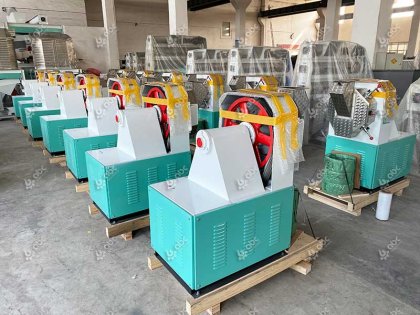The textile industry basically survives due to one plant, cotton. With over 25 billion tonnes produced yearly, the reality is that the quality of cotton produced is still very low. With the methods of production to blame, the cotton stalk is often burned in the fields cotton is picked from. However with advancement in technology came the manufacture of cotton stalk briquette machine. This then makes it possible for cotton pellets to be made into stalk pellets, which can then be used as biomass fuel.

Cotton Stalk Briquettes Made by Punching Briquette Machine
Therefore, it is profitable to make cotton stalk into biomass pellets and briquettes fuel. More and more people turn the surplus waste of cotton into an available resource. As shown in the finished product diagram of cotton stalk briquette produced by punching briquetting machine below, biomass pellets and briquettes machine fuel provide convenience for a large of manufacturers. The raw materials for making biomass particles are not only cotton stalk, but also sawdust, wheat straw, coconut shell, peanut shell and so on. If you want to know more about the process of making biomass pellet fuel by stamping rod machine, please get free and contact us!
The raw materials for making biomass particles are not only cotton stalk, but also sawdust, wheat straw, coconut shell, peanut shell and so on. If you want to know more about the process of making biomass pellet fuel by stamping rod machine, please get free and contact us!
Cotton Stalk Briquetting Process
The cotton stalk briquetting process starts by collection of the cotton stalks. They are then reduced in size, dried and then compacted by a press. With the fact that moisture content, pressing temperature and compacting pressure are the most important things for high quality stalk pellets, the cotton stalk briquette machine ensures the parameters are met. But why make cotton stalk briquettes?- 1. Cotton stalk pretreatment: collect a large number of waste cotton stalks and gather them together before briquetting.
- 2. Crushing: crush the collected cotton stalk into debris, reduce the size and facilitate treatment.
- 3. Drying: the cotton stalk needs to be heated to high temperature to remove moisture. The goal is to reduce the moisture content from 40% to 50% to 12% or less. If this step is ignored, the particles will not be used for fuel production, and the particle surface will be rough.
- 4. Cotton stalk granulation : The most critical step is briquetting. When everything is ready, pressing will begin. Use the biomass briquetting equipment to shape the scattered debris.
| Item | Detail |
|---|---|
| Main parts |
Briquetting machine, Feeder, Control cabinet
|
| Capacity | 0.8-1.2 t/hr |
- 5. Cooling and packaging
Would you like to get a free quotation for a complete small to medium scale cotton stalk briquetting plant? Welcome to click the button below to ask us the price!
Necessity of Making Cotton Stalk Briquettes
• Amounts of raw materialsWith the largest manufacturers of textile industry seeking cotton, plantations in most countries such as India, Pakistan and Uzbekistan have cotton stalk in millions of tonnes as waste. The same countries masses use the same as fuel, however due to its low quality it is usually not enough and has to be supplemented with other sources such as firewood. High quality fuel that will be more than enough for the masses can be made with the cotton stalk briquette machine, reducing wastage by usage of available waste.
• Superior Biomass fuel
Unlike wood and other types of fuels in the world, cotton stalk pellets is no doubt superior. This comes about as with the right amount of porosity, carbon, it burns hot, slowly and with no smoke making it a suitable biomass fuel.
Benefits of Using Cotton Stalk Briquette Machine
• For government economyFor thousands of farmers in the cotton industry, the remaining residue does not have to end up as waste product but as a valued product. With the most traditional method being to burn the remaining stalks after harvesting of the crop, the collection and making of cotton stalk pellets will put it into good use. The process in itself will provide jobs and services to those unemployed, giving them the needed earnings to live comfortably. In addition with cotton earnings usually not sufficient, the earnings from making cotton stalk pellets will reduce the farmer’s reliance on the government. This in turn will ensure the government focuses on more important things. In the industry, the cotton pellets can be used as biomass fuel, replacing non-renewable sources of fuel such as natural gas. This in the long run will reduce the production costs of many items, improving the cost of living.
• For environment
With most farms burning the cotton stalk after harvesting, mass air pollution is normally experienced. In addition soil erosion and decrease in soil usefulness comes in as a negative side effect, which in the end leads to lower yields in cotton in subsequent years. By the manufacture of cotton stall pellets, environmental pollution is reduced significantly making it a valued quality fuel.






















